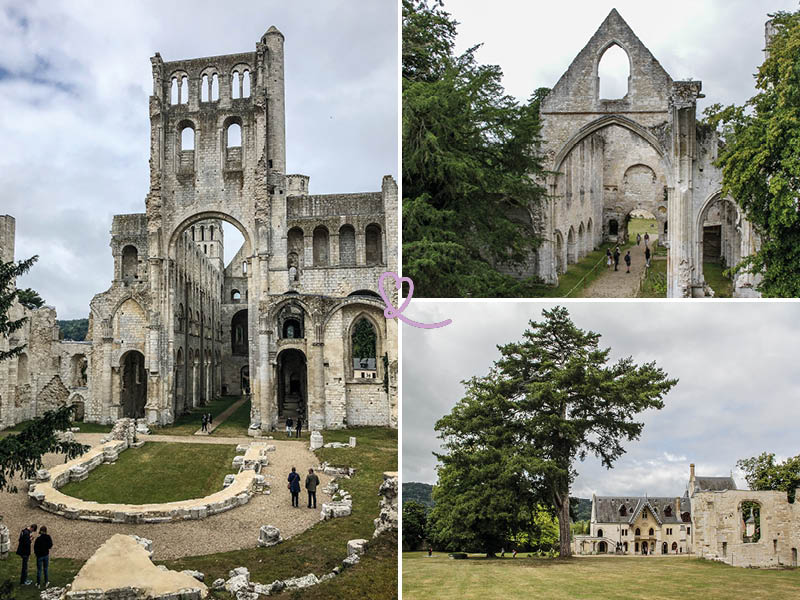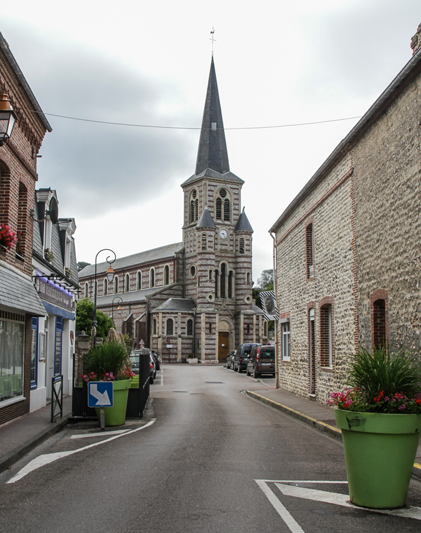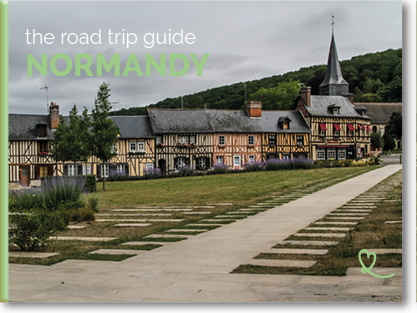Immerse yourself in history by exploring Jumièges Abbey, just outside Rouen! An architectural treasure nestled in the heart of Normandy. A silent witness to centuries gone by, this majestic abbey embodies timeless elegance. Treading its thousand-year-old cobblestones filled us with emotion, and we loved discovering the green setting in which it nestles.
Whether you’re a history buff, an architecture enthusiast or simply awe-struck, we can assure you that a visit to Jumièges Abbey will take you on a journey through the centuries.
Follow us into the corridors of time, and discover in this article our useful tips for uncovering the secrets of this site steeped in history.

This guide is completely independent, based on our experiences. We visited the region anonymously, making our own choices and paying our bills in full.
Why visit Jumièges Abbey?
Is the Abbey worth it? Our opinion:
Without hesitation, we say: absolutely!
This former Benedictine abbey is a remarkable testimony to Norman history. It awakened in us a deep sense of fascination and wonder. One of the most beautiful abbeys in Normandy!

Here you’ll discover the Abbey Church, with its impressive arcades and detailed carvings. It is admired by architecture enthusiasts and the curious alike. The ruins of monastic buildings such as St Peter’s Church and the cloister tell a story of prosperity and decline, war and peace.
We also loved treading the lawns of the peaceful gardens surrounding the abbey. A haven of tranquillity where you can lose yourself and meditate.
Take a guided tour of Normandy’s medieval castles and abbeys! – See prices, opening hours and availability

Why is Jumièges Abbey famous?
Jumièges Abbey is famous for many reasons:
- It is considered one of the finest examples of Romanesque art in Normandy.
- It has a rich history. Founded in the 7th century, it has seen decades of turbulent history: prosperity, decline, wars and rebuilding…
- Jumièges was one of the most important Benedictine abbeys in Normandy, attracting monks and pilgrims from all over the world. It played an essential role in the spread of Christianity.
- The ruins are surrounded by peaceful gardens, creating a unique atmosphere of serenity and contemplation.

Our favorite moments
Our visit was a real “coup de coeur”. Here they are:
- Notre-Dame Abbey: we were struck by its majesty even before we entered the site! Its immense white stone nave stretches gracefully skywards, almost seeming to melt into the Normandy clouds.
- Église Saint-Pierre: in our opinion, this building, which has preserved vestiges from the Carolingian period, is a must-see and fascinating!
- The yew tree, several hundred years old: we were impressed by this tree, which bears witness to all the changes that have taken place in the estate. It connects us directly to history, and keeps alive the spirituality that prevailed when the cloister was still standing.

WHERE TO STAY IN Rouen
Option 1: in the old town center
A charming historic heart, museums and attractions around every corner… We recommend..:
- Gustave Flaubert Literary Hotel with lots of quotes – see prices, photos and availability.
- Hôtel de Bourghteroulde set in a 16th-century residence – see prices, photos and availability.

Option 2: near the station
Just a 10-minute walk from the historic center, you’ll find more modern options. We recommend..:
- Blu Radisson Hotel next to the Jeanne d’Arc Tower – see prices, photos and availability.
- Hotel de Dieppe Best Western and its Art-deco ambience – see prices, photos and availability

History in brief
During your visit, you’ll discover that Jumièges Abbey has had a rich and eventful history.
- Founded around the year 654 by Saint Philibert, it quickly became a major religious and cultural center in the region. We learned that over the following centuries, the abbey prospered, attracting many monks and faithful, and played an important role in the spread of Christianity in Normandy.
- However, like many religious institutions, the abbey was subject to periods of decline and destruction.
In 841, it was sacked and burned by the Vikings, but fortunately quickly rebuilt. - In the 11th century, under the impetus of the Dukes of Normandy, notably William the Conqueror, the abbey underwent a period of renewal and became a remarkable example of Romanesque architecture. We enjoyed our “Romanesque remains hunt” during the tour!

- Over the following centuries, the abbey continued to prosper, but was once again affected by the troubles of history. During the Hundred Years’ War, we discovered that it suffered severe damage.
- Later, during the French Revolution, it was abandoned and sold as national property. We were saddened to learn that its buildings had been dismantled and turned into stone quarries.
- Fortunately, from the 19th century onwards, preservation efforts were undertaken to safeguard what remained of the abbey. You’ll have the chance to discover this unique site with its impressive architecture and rich historical past.

How to get there: Abbaye de Jumièges, Normandy
Where is the Abbey?
The abbey is located at 24 Rue Guillaume le Conquérant, Jumièges.
- 40 minutes from Rouen and 50 minutes from Le Havre, by car
- Near Base de Loisirs de Jumièges
- Close to Château du Taillis and Saint-Wandrille Abbey
OUR ADVICE FOR RENTING A CAR IN Normandy
- Compare prices on our preferred platform: DiscoverCars – one of the best rated sites.
- Choose a car that is comfortable enough (distances can be long) but compact (some parking lots and villages are narrow).
- Think of thecomplete insurance (some roads are tortuous and narrow).
- There is a lot of demand, book it early.

How to get there?
Jumièges is located on the right bank of the Seine, at the end of one of the loops it forms between Rouen (30 km) and Le Havre (50 km).
From the center of Jumièges, you can easily walk to the abbey in less than 5 minutes. Access is easy, it’s all flat.

- By bus: route 207 of the Astuce network. Stop “William the Conqueror” or “Abbey”. Click here for route maps, timetables and fares.
- By ferry: Jumièges stop, then 20min walk. Find out more here.
- By car: to reach the site, you may need to take the freeway, depending on your point of departure.
If you’re coming from the right bank of the Seine, i.e. the Rouen or Le Havre area, you can easily reach the abbey via the departmental roads.
On the other hand, if you’re coming from the left bank, i.e. from Rouen, Paris or Caen for example, you’ll have to cross the Seine by ferry (boat). From Pont de Brotonne there’s a crossing every 20 minutes. The abbey is 800 m from the landing stage.

Parking
Parking is available close to the entrance. However, it is not huge, and may be full on busy days.
There are spaces reserved for people with reduced mobility.
If you’re coming by bike, there are a few spaces available at the entrance for parking your two-wheeler.

DISCOVER Rouen
- Best things to do in Rouen: 15 ideas
- Rouen’s tourist calendar: our selection of events
- Where to stay in Rouen: our best hotels
- Where to eat in Rouen: 20 best restaurants
- Rouen’s 10 best museums
- Itineraries in Rouen: 1 day – 2 days
- Rouen Museum of Fine Arts
- Rouen Cathedral
- Rent a car in Rouen

Useful tips: duration, schedules, eating…
Best time to visit
For a quiet visit, we advise you toavoid the busysummer vacation season.
The abbey is open all year round. Let yourself be tempted, for example, by an autumnal visit to enjoy the freshness and ochre-colored landscapes. Or why not spring? Enjoy the first sunny days and watch nature awaken in the park.

If you choose to visit the abbey in summer, we recommendarriving before 10am or after 4.30pm. That way, you can avoid the crowds and the heat.
In any case, to make the most of the buildings, landscapes and surrounding gardens, it’s best to visit on a rain-free day.

Length of visit and main difficulties
We recommend that you allow between 1h30 and 2h30 to visit the entire site. This time will allow you to explore all the spaces carefully. You can also take a stroll through the park, enjoying its tranquility and immersing yourself in the history of this remarkable place.

We advise you to bring good shoes. You’ll walk on gravel, grass and a few steps. Also, you’ll be outside for most of the tour, so we advise you to be well equipped for the Normandy sun and rain!

- For those with reduced mobility, please note that the abbey grounds are hilly, with gravel access paths. Wheelchair access is difficult. Also, the toilets are not wheelchair accessible.
- For the hearing impaired, the Jumièges 3D application lets you discover the abbey through virtual reality images.
- For people with intellectual disabilities, a FALC (Facile à Lire et à Comprendre) guide and a large-print guide are available at reception.
Find out more here.

Advice on how to visit
The abbey does not really have a predefined direction of visit. The place is so vast that you can easily spend hours there. It all depends on what you want to see.

We recommend several options:
Option number 1: you can opt for a very history-oriented tour, looking at the architectural details of the buildings.
- Start at the Porterie, where you’ll find the reception desk.
- Continue on to the majestic Abbatiale Notre-Dame. Discover its lantern tower and try to make out the remains of the paintings of yesteryear.
- Then admire St-Pierre Church and its Carolingian remains.
- Of course, the Cloister, the Logis Abbatial and the Hôtellerie are not to be missed. They all offer their share of surprises to discover.
- Finish with a stroll in the park.

Option number 2: Let yourself be tempted by a more leisurely stroll through the park. Feel free to approach the buildings that appeal to you.
- Enjoy the peace and quiet of the century-old yew tree planted in place of the former cloister.
- Don’t miss out on the Abatiale’s capitals and discover the Charles VII passageway, which leads to the Saint-Pierre church.
- Pay particular attention to the park’s majestic trees and try to differentiate between the 17th and 18th century sections and the 19th century English gardens.

USE OUR GUIDE TO PLAN A
DREAM TRIP TO Normandy
All the information you need for your trip:
- 8 maps that make planning easier
- 160+ pre-selected locations
- Practical advice
- 300+ photos to help you choose

Visiting with children
The site offers a number of events and activities for children and families.
- During the school vacations, activities for 6-11 year olds are organized on Monday afternoons. The aim is to discover the abbey and its temporary exhibitions in a fun and artistic way.
- Family outings (tours or workshops) are also offered on certain Saturdays.
- Finally, whatever the period, the free Jumièges 3D application and its reconstructions will help children better understand the history of the abbey.
Click here to see our calendar of visits and events.

Your children can also enjoy the green spaces, hiding behind the hundred-year-old trees or rolling around in the grass (well, that’s up to you)!
If you have small children, be aware that there is gravel, stairs and lawns to cross. It is not ideal if you come with a stroller for example, we recommend you rather the baby carrier.

Schedules and rates
Jumièes Abbey is open every day. Here are the timetables:
- April 15 to September 15: 9:30 a.m. – 6:30 p.m.
- September 16 to April 14: 9:30 a.m. to 1 p.m. and 2:30 p.m. to 5:30 p.m.
Admission is €7. Find out more here.
Take a guided tour of Normandy’s medieval castles and abbeys! – See prices, opening hours and availability

Guided tours
Guided tours are organized every day. There’s a departure every hour or so. The guided tour costs €3 in addition to the ticket price.
To make sure you’re able to enjoy it, we strongly recommend that youcall ahead to find out the day’s schedule and reserve your place. Find out more here.

Catering
There are no catering facilities on site. We recommend taking the car to Rouen, the capital of Normandy, which is home to some excellent restaurants. Here are our favorites:
- Restaurant L’Odas (1 star): the menu between land and sea offers several different rhythms: between 3 and 7 beats at lunchtime or 5 and 7 beats in the evening. The chef’s wonders are tasted blind, and our taste buds remember them!
- Restaurant Simone: a relaxed atmosphere for a resolutely creative and daring cuisine, all with a controlled bill.
- Salon de thé Dame Cakes: the perfect place to indulge and relax in the heart of Rouen. The pastries are refined, and you can even have lunch there!
Discover our selection of the city’s best restaurants in our our article on where to eat in Rouen.

Discover the silhouette of Jumièges
As soon as we arrived in Jumièges, we were amazed by the immensity of the Abbey overlooking the village. The great Abbey Church of Notre-Dame appears in all its majesty, its two towers towering skywards. If you can, discover it first from the river, on a cruise or on the ferry that crosses it. Or cycle from the pretty Route des Fruits, if not on the many hiking trails that surround the site and run alongside the Seine.

Considered the most beautiful ruin in France by Victor Hugo, Jumièges Abbey bears witness to the history of the Seine Valley, from the Vikings to the Revolution. It is one of the oldest and most important monasteries in the West.

Overview: the treasures of Jumièges Abbey
As soon as you enter the Parc de l’Abbaye, you’ll notice that the estate is huge. In this article, we present the buildings and places that impressed us most during our visit. However, there’s plenty to see, so make sure you don’t miss out, as every building has its own surprises in store!

Here’s what you can visit:
- The gatehouse and its 14th-century porch. It houses the reception and exhibition rooms.
- The Abbatiale Notre-Dame, a Romanesque masterpiece built between 1040 and 1060.
- Saint-Pierre Church and its Carolingian remains.
- The cloister and its centuries-old yew tree.
- The hostelry, a 12th-century Gothic room.
- The abbey dwelling, a 17th-century manor house.
- The 15-hectare park, listed since 1947, is home to some remarkable trees.
- The cellar, a large room combining Romanesque and Gothic architecture.

Start of tour: Notre-Dame Abbey Church
Our visit begins with the discovery of the site’s centerpiece. This majestic church, built in the 11th century, is a masterpiece of Norman Romanesque architecture. The tour taught us that the Abbatiale Notre-Dame was the spiritual heart of the abbey. Monks gathered here for religious services and ceremonies.

You’ll see that it stands out for its impressive dimensions, imposing façade and elegant architectural features. We found that its open-air nave made it even more majestic. It seemed to watch over the valley.

Don‘t miss: the “Westwerk” or “Western Massif” on the west façade. This is a particular type of Romanesque church façade, extremely rare in France. Find out more here. Here, it is surrounded by 2 impressive columns 46m high!

Have you noticed the immensity and majesty of the nave? At 25 metres high, it is the tallest Romanesque nave in Normandy! Its impressive length and massive columns gave us the impression of a vast, imposing space. We enjoyed strolling through its 6 bays.

Don‘t miss: look for the remains of the sculptures and paintings that once adorned Notre-Dame. They can still be admired on the capitals, pillars and cross vaults of the aisles.

The west wall of the lantern tower
Continue your visit to the back of the abbey church and head for the remains of the choir. You can see the remains of a 2-storey lantern tower. We discovered that this type of openwork tower rises from the transept of a church to illuminate the interior space through its numerous openings.

Here, only the west wall remains, yet it’s one of the best-preserved parts of the building. Taking into account its dimensions – around 20m high and 15m wide – we imagined how this tower could illuminate the transept crossing.

Continued exploration: St-Pierre Church and Cloister
We loved discovering Saint-Pierre Church, where the oldest remains of Jumièges Abbey lie, bearing witness to its Carolingian past. We also enjoyed the exercise in imagination required to discover the cloister’s former location. Once at the heart of monastic life, an if witness to all those years remains in what was once the center of the building.

Saint-Pierre Church, the origins of the Abbey
Leaving the Abbatiale Notre-Dame, take the Passage Charles VII. It is directly linked to St. Peter’s Church.
This building is the oldest part of the abbey. We were amazed to see vestiges of the Carolingian period! In particular, the façade and the first two bays of the nave. The rest of the nave and side aisles, rebuilt in the 13th and 14th centuries, are in the Gothic style.

These stones have witnessed all the changes in society, wars, reconstructions, revolutions… and are still there today to bear witness to Normandy’s rich historical past. This idea made our visit even more enjoyable.
Don’t miss: before you leave, head for the south wall. Here you can admire a rare example of Carolingian painting: a male bust figure.

The Cloister, heart of the Abbey
We learned that the cloister, located at the heart of the abbey, served as a link between the main monastic buildings. The Notre-Dame and Saint-Pierre churches, the chapter house, the treasury room, the former hostelry room and the refectory, which has since disappeared. Both a place of passage and meditation, it’s easy to imagine the solemn yet hectic atmosphere that once reigned here.

Unfortunately, today only traces of this remain, so you’ll have to use your imagination. Rebuilt in 1530, it features a blend of flamboyant Gothic and Renaissance styles.
Here are a few things to get you thinking about when you step out onto the lawn where this building once stood:
- The trapezoidal cloister of Jumièges Abbey measured between 28 and 40 meters on each side.
- Its 4 galleries, crowned with balustrades, were supported by buttresses adorned with pinnacles. Each bay was lit by a large window.
- The star-shaped vaults were richly decorated with hanging keys and culs-de-lampe.
- Finally, the walls were adorned with frescoes depicting the history or legends of the abbey.

Don‘t miss: we loved the fact that the center of the cloister is marked by a yew tree several hundred years old. Do you realize that this tree was planted in the 16th century? A symbol of eternal life, it remains a living witness to a bygone era.
End of visit: the park of Jumièges Abbey
Jumièges Abbey is set in 15 hectares of enclosed parkland, listed since 1947. We loved walking around it, enjoying its peace and freshness.
As we explored, we discovered that the park has been developed over the centuries.

The Mauret landscaping
The visit revealed that a detailed plan of the gardens was drawn up in 1797. It provides a valuable cartography of the developments carried out by Benedictine (Maurist) monks in the 17th and 18th centuries. You’ll discover them as you head towards the south-eastern part of the site.

We liked the terrace system. Access is via a staircase, offering a different view of the abbey grounds. If you follow the terraces all the way to the end, you’ll see the abbots’ last dwelling, built in the 1670s, on your right.

Now head for the southern section, known as Clos de la Vigne. You’ll see a double avenue of lime trees leading up to the gate named “d’Agnès Sorel”. We were surprised by the “thabor”, an artificial mound symbolizing the Mount of the Transfiguration of Christ.
English-style gardens, the hallmark of the 19th century
Continue your tour of the park, enjoying its peaceful, verdant setting. As you stroll along, you’ll discover that new landscaping changes were undertaken in the 19th century.
The park is what it is today thanks in large part to this work. Their aim was to enhance the ruins. We think it’s a success! English-style gardens were laid out on the abbey grounds in the 1900s.

A parterre of boxwood embroidery was planted below the abbey dwelling. It inspired the current flowerbed, planted in the 1980s. Have you noticed?
The landscaping work also featured something we really liked: the park’s remarkable trees! Have you noticed the purple beeches or the tall pines near the gatehouse?

Don’t miss: unfortunately, a storm in 1999 tore down the great Atlas cedar. We invite you to take a look at its barrel, preserved at the Clos de la Vigne center. If you feel like it, come closer and you’ll be able to smell the fragrance of the wood!

Subscribe to our Newsletter
- Get away from it all with Region Lovers’ beautiful destinations!
- Once a month
- Advertising-free
Frequently asked questions
Are there any events organized at Jumièges Abbey?
Yes, there are events organized at Jumièges Abbey throughout the year. Here are a few examples:
- Guided and themed tours are offered daily, in French and English, and the themed tours cover topics such as Romanesque architecture and the life of the monks.
- Workshops, events and shows for young and old are organized in the abbey throughout the year.
For more information on events at Jumièges Abbey, please consult the abbey diary here.

Are there temporary exhibitions at Jumièges Abbey?
Yes, it is possible to see temporary exhibitions at Jumièges Abbey.
The abbey offers a year-round program of temporary exhibitions in the logis abbatial. These exhibitions cover a wide range of themes, including the abbey’s history, art, archaeology and Norman heritage. Find out more here.

What else can you do in Jumièges?
Jumièges is a commune surrounded by an abundance of nature and located on the banks of the Seine. It brings together nature and heritage lovers. During your stay, you can hike, cycle or enjoy the river with water sports such as boating or canoeing.
Jumièges is also close to 2 major cities in Normandy:
- The capital of Normandy, Rouen, where there are lots of things to do and places to visit.
- Le Havre, where there’s so much to discover: heritage, history, architecture, beaches, art…

PLAN YOUR TRIP TO Normandy
Inspiration destinations
- Deciding where to go in Normandy – the best destinations
- Our weekend ideas: best-of, romantic, unusual, seaside, luxury, family
- 16 seaside hotels in Normandy
- The most beautiful charming hotels in Normandy

Best of

Practice
- Where to stay in Normandy – best places and hotels
- See our tips for renting a car at CDG airport, Orly airport, Beauvais airport, Caen, Rouen, Bayeux…






